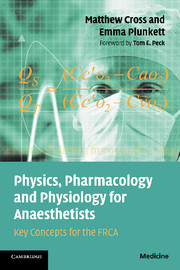Book contents
- Frontmatter
- Contents
- Acknowledgements
- Preface
- Foreword
- Introduction
- Section 1 Mathematical principles
- Section 2 Physical principles
- Section 3 Pharmacological principles
- Section 4 Pharmacodynamics
- Section 5 Pharmacokinetics
- Section 6 Respiratory physiology
- Section 7 Cardiovascular physiology
- Section 8 Renal physiology
- Section 9 Neurophysiology
- Section 10 Statistical principles
- Appendix
- Index
Foreword
Published online by Cambridge University Press: 15 January 2010
- Frontmatter
- Contents
- Acknowledgements
- Preface
- Foreword
- Introduction
- Section 1 Mathematical principles
- Section 2 Physical principles
- Section 3 Pharmacological principles
- Section 4 Pharmacodynamics
- Section 5 Pharmacokinetics
- Section 6 Respiratory physiology
- Section 7 Cardiovascular physiology
- Section 8 Renal physiology
- Section 9 Neurophysiology
- Section 10 Statistical principles
- Appendix
- Index
Summary
Many things are currently in a state of flux within the world of medical education and training, and the way in which candidates approach examinations is no exception. Gone are the days when large weighty works are the first port of call from which to start the learning experience. Trainees know that there are more efficient ways to get their heads around the concepts that are required in order to make sense of the facts.
It is said that a picture says a thousand words and this extends to diagrams as well. However, diagrams can be a double-edged sword for trainees unless they are accompanied by the relevant level of detail. Failure to label the axis, or to get the scale so wrong that the curve becomes contradictory is at best confusing.
This book will give back the edge to the examination candidate if they digest its contents. It is crammed full of precise, clear and well-labelled diagrams. In addition, the explanations are well structured and leave the reader with a clear understanding of the main point of the diagram and any additional information where required. It is also crammed full of definitions and derivations that are very accessible.
It has been pitched at those studying for the primary FRCA examination and I have no doubt that they will find it a useful resource. Due to its size, it is never going to have the last word, but it is not trying to achieve that.
- Type
- Chapter
- Information
- Physics, Pharmacology and Physiology for AnaesthetistsKey Concepts for the FRCA, pp. xiii - xivPublisher: Cambridge University PressPrint publication year: 2008



